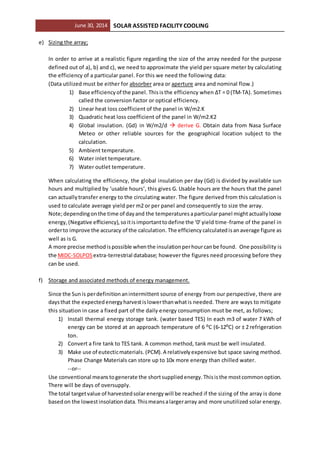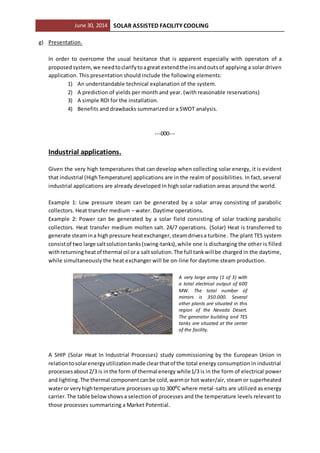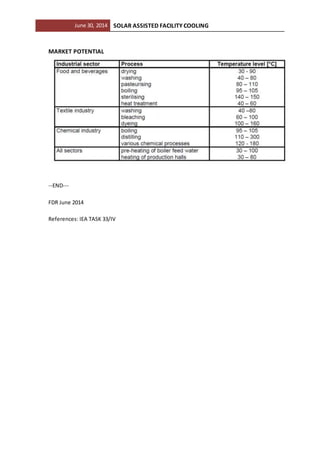Solar cooling has lots of advantages
- 1. June 30, 2014 SOLAR ASSISTED FACILITY COOLING Utilizing SOLŌĆÖs Energy The advantages: ’é¦ Solar cooling is particularly useful in the summer months or in tropical regions throughout the year because of the increasedamountof solarenergythat is available and the apparent demand for cooling energy. ’é¦ The match between the plants performance profile and the consumption profile makes it possible to have a very efficient energy supply system without the need for a large store. ’é¦ Conventional air-conditioning systems have a substantially higher level of electricity consumption, which represents an enormous load for the power grids. For solar cooling, only approx. 20 % of the power needed for conventional cooling is required. ’é¦ Solar plants are environmentally friendly. Solar cooling reduces the burden on the environment to a minimum. These plants are operated with environmentally friendly refrigerants and they do not emit any CO2 emissions. This represents a significant step towards achieving the climate targets. ’é¦ Comparedtoconventional coolingsystems,the life time of the components of a solar plant is substantially longer (20-25 years). ’é¦ Cost savings also play a crucial role. This means that the ongoing energy costs, e.g. for gas, coal,oil,are substantiallyreducedas the solar cooling is operated using solar energy. Costs are only incurred for any back-up system that may be required. ’é¦ As solar plants contain virtually no moving parts, the maintenance and repair costs are reduced considerably. How to proceed: a) At first there needs to be clear understanding of the load balance of the facility. Generally for buildings or facilities in sub-tropical or tropical regions, the thermal consumption exceeds the electrical consumptionintermsof climate control versus lightingandpower.Anin-depth survey has to be conducted. From the data collected, a target needs to be developed what states the desiredlevel of grid energy replacement for solar energy. This number will be a percentage of total building load or kWh/yr. b) A secondconsiderationisthe space insquare metersavailableforasolar thermal applicationfor capturing of the available insolation. Solar irradiation or global solar potential is expressed in kWh/m2/dayor peryear.Not all of thisenergycan be capturedsince the ŌĆścollectorŌĆÖ is subject to various categories of energy losses both internal and external. (F.i. Reflection, radiation, heat transfer coefficients etc.) c) A thirdconsideration,whichhas correlation with a) and b), is the method of energy conversion that will be utilized in order to convert solar heat into building cooling/heating. (Climate- control). The choices here are ŌĆślow temperatureŌĆÖ and ŌĆśmedium temperatureŌĆÖ conversion. Both methodshave theirspecificproperties, furtherexplainedbelow.(There is a third method that is not consideredhere and this concerns ŌĆśhigh temperatureŌĆÖ conversion where the collectors are more of an industrial type and support industrial processes.)
- 2. June 30, 2014 SOLAR ASSISTED FACILITY COOLING ’é¦ Low temperature collection is usually done with ŌĆśflat plateŌĆÖ collectors. These are developedfordomesticpurposes(hotwatergeneration) butare alsosuitable for energy conversion by means of desiccant adsorption chilling and single effect absorption chilling.Desiccantintake airtreatment(de-humidification)isanadditional way to utilize low temperature solar heat. The temperatures associated with this method are in the range of 60 ŌĆō 90 Ōü░C. Efficiencies(dailyaverage) will be in the order of ┬▒40%. This means that of an average insolation of 5 kWh/m2/day, 2 kWh/m2/day can be captured and utilized. ’é¦ Mediumtemperature collection is either done with ŌĆśadvanced flat plateŌĆÖ or ŌĆśevacuated tubeŌĆÖ collectors. These are particularly meant for dual effect chilling and medium temperature processes since the water outlet temperature of these collectors can be over 100 Ōü░C. (Up to 150 Ōü░C is possible when the system is suitably pressurized, P=4.8 Bara). Efficiencies of evacuated tube collectors can be in the order of >50% (daily average). d) The choice of collector type; ’é¦ As is described above, the choice of collector mainly depends on 3 considerations; i. Expected outcome in terms of energy collection. ii. Space Available. iii. Choice of temperature and associated equipment. Several types are commonly used. (In order off increasing efficiency) # Collector type Execution Remarks 1 Flat Plate An insulated box with an anti- reflective glass cover where an absorber plate is joined with a set of tubes forming aninlet/outlet header. The cheapest andmost simple type of solar collector. Commonly used in domestic water heating. 2 AdvancedFlat Plate An insulated box with double anti- reflective glass covers where an absorber plate is joined with a set of tubes forming aninlet/outlet header connected by tubes. A better type than 1 since it is provided with double glazing, addingadditional insulation. Some panels are filled with an inert gas. Some types can be used as roof panels (S.O.L.I.D) 3 Evacuated tube ( heat-pipe) A set of boronsilicate glass tubes that are evacuated(vacuum) in which an absorber plate with a heat pipe is fitted. The condenser of the heat- pipe gives its heat off in the (single) header of the panel. This type comes in many versions. Tube diameter is important, with greater diameters, more efficiency can be expected. Comes in 48-55-60-70- 100mm tubes. 4 Evacuatedtube (u- pipe) A set of boronsilicate glass tubes that are evacuated(vacuum) in which an absorber plate with two pipes are fitted. The pipes are directly connected to inlet/outlet headers. This type comes in many versions. Tube diameter is important, with greater diameters, more efficiency can be expected. See above. 5 Evacuated tube (concentrated) Same as 3 and 4; However, at the back side of the tubes, mirrors are placedsothat the absorber benefits from reflectedirradiationat the back of the tubes. The most efficient type if providedwith u-tubes. Higher temperatures are possible. (Upto 180 Ōü░C.) A Sub-type is the SydneyTube, a double tube design with selective absorber.
- 3. June 30, 2014 SOLAR ASSISTED FACILITY COOLING e) Sizing the array; In order to arrive at a realistic figure regarding the size of the array needed for the purpose defined out of a), b) and c), we need to approximate the yield per square meter by calculating the efficiency of a particular panel. For this we need the following data: (Data utilized must be either for absorber area or aperture area and nominal flow.) 1) Base efficiencyof the panel. Thisisthe efficiency when ŌłåT = 0 (TM-TA). Sometimes called the conversion factor or optical efficiency. 2) Linear heat loss coefficient of the panel in W/m2.K 3) Quadratic heat loss coefficient of the panel in W/m2.K2 4) Global insulation. (Gd) in W/m2/d ’āĀ derive G. Obtain data from Nasa Surface Meteo or other reliable sources for the geographical location subject to the calculation. 5) Ambient temperature. 6) Water inlet temperature. 7) Water outlet temperature. When calculating the efficiency, the global insulation per day (Gd) is divided by available sun hours and multiplied by ŌĆśusable hoursŌĆÖ, this gives G. Usable hours are the hours that the panel can actuallytransfer energy to the circulating water. The figure derived from this calculation is used to calculate average yield per m2 or per panel and consequently to size the array. Note;dependingonthe time of dayand the temperatures aparticularpanel mightactuallyloose energy, (Negative efficiency),soitisimportanttodefine the ŌĆś0ŌĆÖyield time-frame of the panel in orderto improve the accuracy of the calculation. The efficiency calculatedisanaverage figure as well as is G. A more precise methodispossible whenthe insulationperhourcanbe found. One possibility is the MIDC-SOLPOSextra-terrestrial database; however the figures need processing before they can be used. f) Storage and associated methods of energy management. Since the Sunis perdefinitionanintermittent source of energy from our perspective, there are daysthat the expectedenergyharvestislowerthanwhatis needed. There are ways to mitigate this situation in case a fixed part of the daily energy consumption must be met, as follows; 1) Install thermal energy storage tank. (water based TES) In each m3 of water 7 kWh of energy can be stored at an approach temperature of 6 Ōü░C (6-12Ōü░C) or ┬▒ 2 refrigeration ton. 2) Convert a fire tank to TES tank. A common method, tank must be well insulated. 3) Make use of eutecticmaterials. (PCM).A relativelyexpensive but space saving method. Phase Change Materials can store up to 10x more energy than chilled water. --or-- Use conventional meanstogenerate the shortsupplied energy. Thisisthe mostcommonoption. There will be days of oversupply. The total targetvalue of harvestedsolar energy will be reached if the sizing of the array is done basedon the lowestinsolationdata.Thismeansalargerarray and more unutilized solar energy.
- 4. June 30, 2014 SOLAR ASSISTED FACILITY COOLING g) Presentation. In order to overcome the usual hesitance that is apparent especially with operators of a proposed system,we needtoclarifytoagreat extendthe insandoutsof applying a solar driven application. This presentation should include the following elements: 1) An understandable technical explanation of the system. 2) A prediction of yields per month and year. (with reasonable reservations) 3) A simple ROI for the installation. 4) Benefits and drawbacks summarized or a SWOT analysis. ---000--- Industrial applications. Given the very high temperatures that can develop when collecting solar energy, it is evident that industrial (HighTemperature) applications are in the realm of possibilities. In fact, several industrial applications are already developed in high solar radiation areas around the world. Example 1: Low pressure steam can be generated by a solar array consisting of parabolic collectors. Heat transfer medium ŌĆō water. Daytime operations. Example 2: Power can be generated by a solar field consisting of solar tracking parabolic collectors. Heat transfer medium molten salt. 24/7 operations. (Solar) Heat is transferred to generate steamina highpressure heatexchanger,steamdrivesa turbine. The plant TES system consistof two large saltsolutiontanks(swing-tanks),while one is discharging the other is filled withreturningheatof thermal oil ora salt solution.The full tankwill be charged in the daytime, while simultaneously the heat exchanger will be on-line for daytime steam production. A very large array (1 of 3) with a total electrical output of 600 MW. The total number of mirrors is 350.000. Several other plants are situated in this region of the Nevada Desert. The generator building and TES tanks are situated at the center of the facility. A SHIP (Solar Heat In Industrial Processes) study commissioning by the European Union in relationtosolarenergyutilizationmade clearthatof the total energy consumption in industrial processesabout2/3 is inthe form of thermal energy while1/3 is in the form of electrical power and lighting.The thermal component canbe cold, warmor hot water/air, steam or superheated wateror veryhightemperature processes up to 300Ōü░C where metal-salts are utilized as energy carrier.The table belowshowsa selection of processes and the temperature levels relevant to those processes summarizing a Market Potential.
- 5. June 30, 2014 SOLAR ASSISTED FACILITY COOLING MARKET POTENTIAL --END--- FDR June 2014 References: IEA TASK 33/IV




